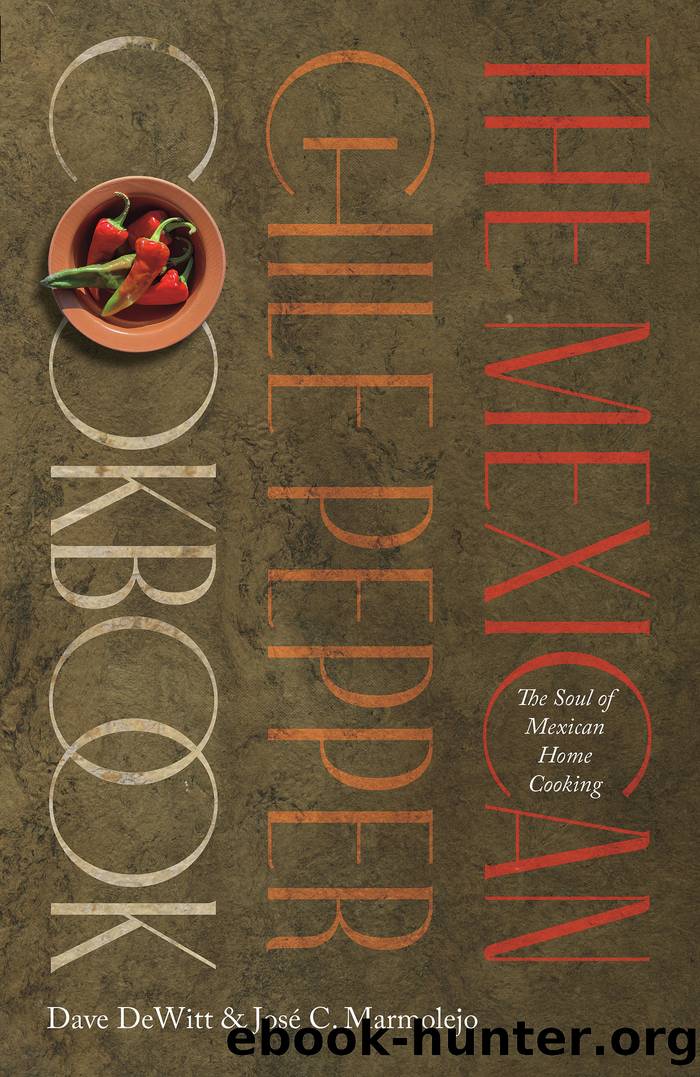The Mexican Chile Pepper Cookbook by DeWitt Dave;Marmolejo José C.;

Author:DeWitt, Dave;Marmolejo, José C.;
Language: eng
Format: epub
Publisher: University of New Mexico Press
Published: 2022-03-15T00:00:00+00:00
Tamales ready for the sauce. Photograph by Chel Beeson. Work for hire. Sunbelt Archives.
Corn husk (top) and banana leaf tamales. Photograph by José C. Marmolejo.
After analyzing countless varieties of tamales, José feels confident that anyone can design their own tamales. There are certain rules to follow to ensure that they will come out well: the type of masa to be used, the ratio of lard/shortening to masa, and the cooking time. The rest is pure creativityâincluding a tamal without masa.
There are, however, some extraordinary tamales in Mexico that he wouldnât dare to try to execute. Zacahuil would be one of them. These extraordinary tamales are from the Huasteca region, an area comprising the southern part of the state of Tamaulipas, north of the state of Veracruz, and east of the state of San Luis Potosà and some areas bordering those states. These tamales are big: up to six feet long and weighing fifty pounds. Needless to say, a project of that magnitude surpasses his ability to prepare and consume them, but something could be done; check the recipes below. You may begin to think that such a project needs the effort of a team and canât be repeated often, and youâre right. It takes a big familyâperhaps some neighbors, tooâand a special occasion to embark on such an adventure. But big families abound in Mexico, and excuses to celebrate do as well: birthdays, baptisms, weddings, and of course, the Day of the Dead.
As mentioned above, the type of masa is determinant. The masa used for tortillas is not the same as the one used for tamales. Masa for tamales is a coarser grind of the corn, and the masa for zacahuil is no exception. In fact, for this giant, the masa is even coarser, even granulated. Think of couscous or cooked broken grains of riceâthatâs the desired texture. The âfillingâ in this tamal is not placed at the center; itâs mixed with the masa to ensure everybody gets some of it. Chicken, turkey, or pork, and a spicy sauce will flavor the zacahuil. There is also the ratio of lard or shortening to masa to consider, as previously mentioned. Two generations ago, it used to be 50 percent lard to 50 percent masa. Concerns over high-cholesterol (which genetically not all of us are susceptible to) resulted in the introduction of shortening, and so the corn meal to shortening ratios began to change to todayâs recommended 60 percent masa to 15 to 20 percent lard and 15 to 20 percent shortening. About the cooking time: a standard tamal takes about an hour of steaming to be ready whereas zacahuil takes between 8 and 12 hours to bake. Yes, such a tamale needs to be baked, and for that task, a big pit or an adobe oven is the solution. The zacahuil needs to be wrapped in a bunch of papatlaâa local wild plant with wide leavesâor banana leaves. Tying up this baby properly is essential before cooking it because we donât want it to fall apart!
Corundas are another example of difficult tamales to execute.
Download
This site does not store any files on its server. We only index and link to content provided by other sites. Please contact the content providers to delete copyright contents if any and email us, we'll remove relevant links or contents immediately.
| Cheese & Dairy | Chocolate |
| Fish & Seafood | Fruits |
| Herbs, Spices & Condiments | Meat & Game |
| Natural Foods | Pasta & Noodles |
| Potatoes | Poultry |
| Rice & Grains | Vegetables |
The Sprouting Book by Ann Wigmore(3424)
Better Homes and Gardens New Cookbook by Better Homes & Gardens(3389)
Trullo by Tim Siadatan(3315)
Super Food Family Classics by Jamie Oliver(3256)
Panini by Carlo Middione(3175)
Hedgerow by John Wright(3128)
Bread Revolution by Peter Reinhart(3001)
Sauces by James Peterson(2972)
Jam by Jam (epub)(2890)
Ottolenghi - The Cookbook by Yotam Ottolenghi(2748)
Oh She Glows Every Day by Angela Liddon(2639)
My Pantry by Alice Waters(2448)
Hot Sauce Nation by Denver Nicks(2385)
The Culinary Herbal by Susan Belsinger(2342)
Veg by Jamie Oliver(2323)
The Art of Making Gelato by Morgan Morano(2166)
Wanderlust by Jeff Krasno(2151)
Meathooked by Marta Zaraska(2151)
Basic Illustrated Edible and Medicinal Mushrooms by Jim Meuninck(2133)
